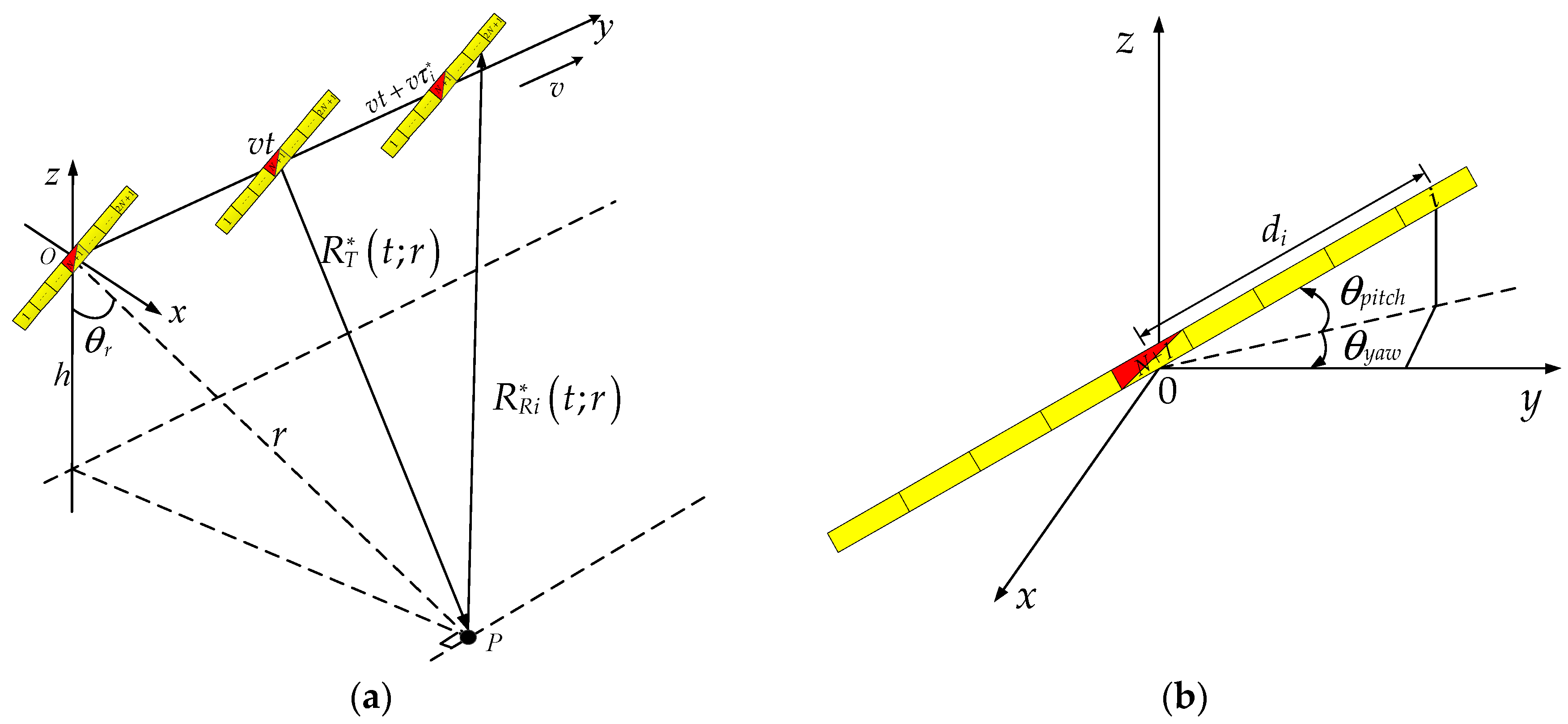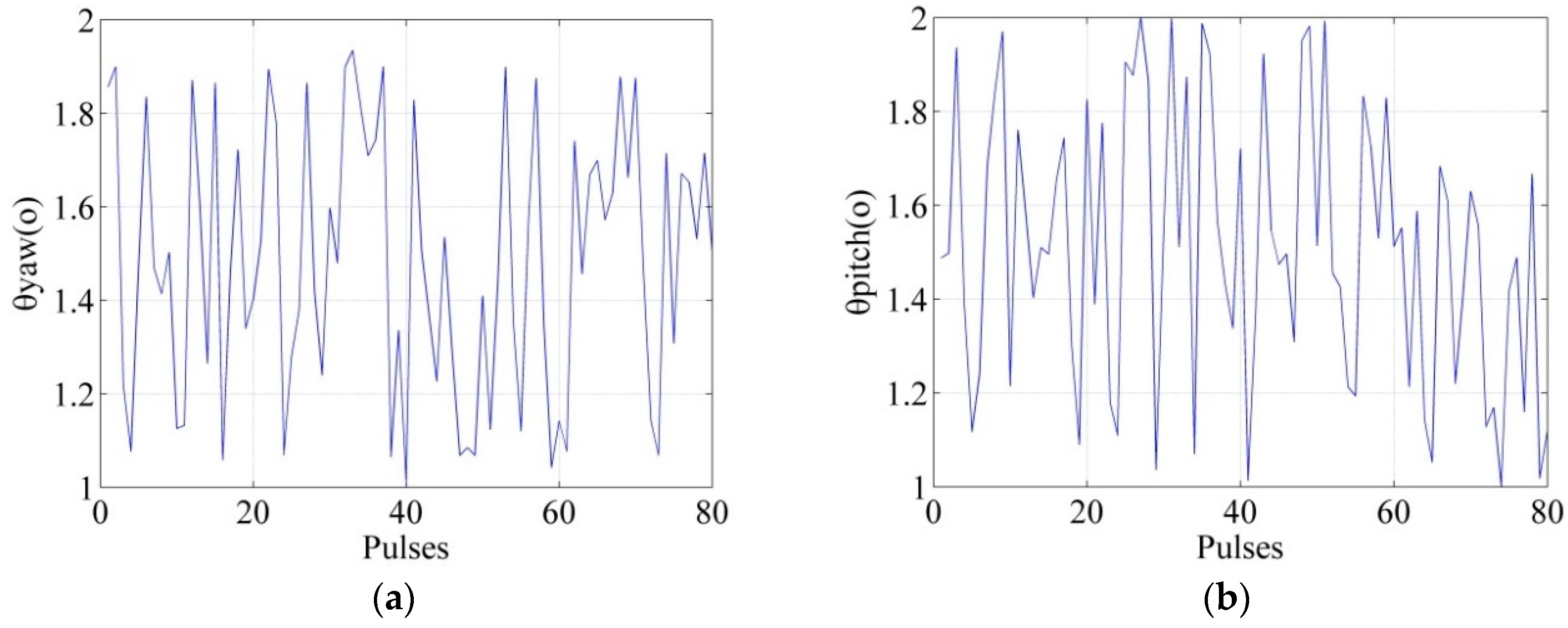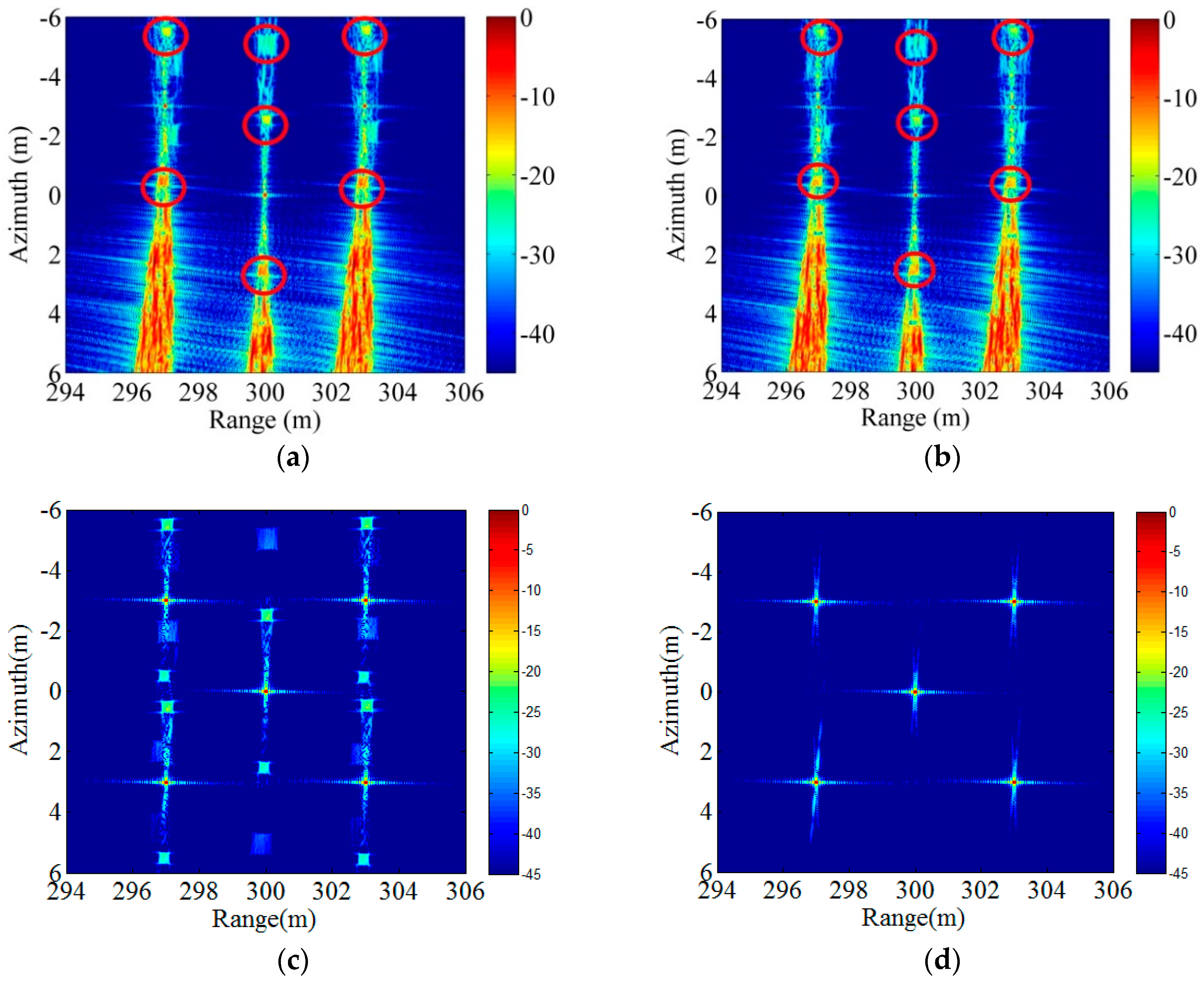A Correction Approach for the Inclined Array of Hydrophones in Synthetic Aperture Sonar
Abstract
:1. Introduction
2. The Development of Correction Approach
2.1. The Exact Acoustic Propagation Path
2.2. The Approximated Acoustic Propagation Path
2.3. The Echo Signal Model
2.4. The Correction Process
3. Results
3.1. Simulation Parameters
3.2. Approximate Errors
3.3. Imaging Results
4. Conclusions
Author Contributions
Funding
Acknowledgments
Conflicts of Interest
References
- Marx, D.; Nelson, M.; Chang, E.; Gillespie, W.; Putney, A.; Warman, K. An introduction to synthetic aperture sonar. In Proceedings of the Tenth IEEE Workshop on Statistical Signal and Array Processing, Pocono Manor, PA, USA, 16 August 2000. [Google Scholar]
- Hansen, R.E.; Callow, H.J.; Saeboe, T.O.; Synnes, S.A.V. Challenges in Seafloor Imaging and Mapping with Synthetic Aperture Sonar. IEEE Trans. Geosci. Remote Sens. 2011, 49, 3677–3687. [Google Scholar] [CrossRef]
- Hayes, M.P.; Gough, P.T. Synthetic Aperture Sonar: A Review of Current Status. IEEE J. Ocean. Eng. 2009, 34, 207–224. [Google Scholar] [CrossRef]
- Griffiths, H.D. Synthetic aperture imaging with sonar and radar: A comparison. In Proceedings of the World Congress on Ultrasonics, Paris, France, 7–10 September 2003. [Google Scholar]
- Hayes, M.P.; Gough, P.T. Interferometric synthetic aperture processing: A comparison of sonar and radar. J. Acoust. Soc. Am. 2008, 123, 3907. [Google Scholar] [CrossRef]
- Putney, A.; Chang, E.; Chatham, R.; Marx, D.; Nelson, M.; Warman, L.K. Synthetic aperture sonar-the modern method of underwater remote sensing. In Proceedings of the IEEE Aerospace Conference, Big Sky, MT, USA, 10–17 March 2001. [Google Scholar]
- Pengfei, Z.; Zelin, J.; Wei, L.; Jiyuan, L.; Chunhua, Z. A motion compensation method for wide-swath synthetic aperture sonar. Chin. J. Acoust. 2016, 35, 277–290. [Google Scholar]
- Heremans, R.; Dupont, Y.; Acheroy, M. Motion Compensation in High Resolution Synthetic Aperture Sonar (SAS) Images. In Advances in Sonar Technology, 1st ed.; Sergio, S., Ed.; IntechOpen: London, UK, 2009; pp. 55–56. ISBN 978-3-902613-48-6. [Google Scholar]
- Legris, M.; Jean, F. Comparison between DPCA Algorithm and Inertial Navigation on the Ixsea Shadows SAS. In Proceedings of the OCEANS 2007, Aberdeen, UK, 18–21 June 2007. [Google Scholar]
- Wilkinson, D.R. Efficient Image Reconstruction Techniques for a Multiple-Receiver Synthetic Aperture Sonar. Ph.D. Thesis, University of Canterbury, Christchurch, New Zealand, 2001. [Google Scholar]
- Bellettini, A.; Pinto, M. Design and Experimental Results of a 300-kHz Synthetic Aperture Sonar Optimized for Shallow-Water Operations. IEEE J. Ocean. Eng. 2009, 34, 285–293. [Google Scholar] [CrossRef]
- Callow, H.J.; Hayes, M.P.; Gough, P.T. Motion-Compensation Improvement for Widebeam, Multiple-Receiver SAS Systems. IEEE J. Ocean. Eng. 2009, 34, 262–268. [Google Scholar] [CrossRef]
- Bonifant, W.W.; Richards, M.A.; McClellan, J.H. Interferometric height estimation of the seafloor via synthetic aperture sonar in the presence of motion errors. IEE Proc.-Radar Sonar Navig. 2000, 147, 322–330. [Google Scholar] [CrossRef]
- Gough, P.T.; Miller, M.A. Displaced ping imaging autofocus for a multi-hydrophone SAS. IEE Proc.-Radar Sonar Navig. 2004, 151, 163–170. [Google Scholar] [CrossRef]
- Leier, S.; Zoubir, A.M. Quality assessment of synthetic aperture sonar images based on a single ping reference. In Proceedings of the OCEANS 2007, Santander, Spain, 6–9 June 2011. [Google Scholar]
- Bellettini, A.; Pinto, M.A. Theoretical accuracy of synthetic aperture sonar micronavigation using a displaced phase-center antenna. IEEE J. Ocean. Eng. 2002, 27, 780–789. [Google Scholar] [CrossRef]
- Callow, H.J. Signal Processing for Synthetic Aperture Sonar Image Enhancement. Ph.D. Thesis, University of Canterbury, Christchurch, New Zealand, 2003. [Google Scholar]
- Heremans, R.; Acheroy, M.; Dupont, Y. 3B-6 Motion Compensation on Synthetic Aperture Sonar Images. In Proceedings of the 2006 IEEE Ultrasonics Symposium, Vancouver, BC, Canada, 2–6 October 2006. [Google Scholar]
- Hawkins, D.W. Synthetic Aperture Imaging Algorithms: With application to wide bandwidth sonar. Ph.D. Thesis, University of Canterbury, Canterbury, New Zealand, 1996. [Google Scholar]
- Gough, P.T.; Hawkins, D.W. Imaging algorithms for a strip-map synthetic aperture sonar: Minimizing the effects of aperture errors and aperture undersampling. IEEE J. Ocean. Eng. 1997, 22, 27–39. [Google Scholar] [CrossRef]
- Banks, S.; Griffiths, H. Imaging and motion estimation for synthetic aperture sonar based on fast factorised back-projection. In Proceedings of the Sixth European Conference on Underwater Acoustics, Gdansk, Poland, 24–27 June 2002. [Google Scholar]
- Cumming, I.G.; Wong, F.H. Digital Processing of Synthetic Aperture Radar Data: Algorithms and Implementation, 1st ed.; Artech House: Norwood, MA, USA, 2005; ISBN 1-58053-058-3. [Google Scholar]
- Huang, J.; Tang, J.; Wang, Q.; Wu, W. Motion Compensation in SAS with Multiple Receivers Based on ISCFT Imaging Algorithm. In Proceedings of the 2nd International Conference on Information Engineering and Computer Science, Wuhan, China, 25–26 December 2010. [Google Scholar]
- Wu, H.; Tang, J.; Zhong, H. A nonlinear chirp scaling algorithm for processing multi-receiver SAS data with small squint angle. In Proceedings of the 2017 International Conference on Wireless Communication and Computer Science, Phuket, Thailand, 29–30 December 2017. [Google Scholar]
- Tian, Z.; Tang, J.; Zhong, H.; Zhang, S. Extended Range Doppler Algorithm for Multiple-Receiver Synthetic Aperture Sonar Based on Exact Analytical Two-Dimensional Spectrum. IEEE J. Ocean. Eng. 2016, 41, 164–174. [Google Scholar]
- Bonifant, W.W. Interferometic Synthetic Aperture Sonar Processing. Ph.D. Thesis, Georgia Institute of Technology, Atlanta, GA, USA, 1999. [Google Scholar]
- Zhang, X.; Tang, J.; Zhong, H. Multireceiver Correction for the Chirp Scaling Algorithm in Synthetic Aperture Sonar. IEEE J. Ocean. Eng. 2014, 39, 472–481. [Google Scholar] [CrossRef]
- Gebert, N. Multi-Channel Azimuth Processing for High-Resolution Wide-Swath SAR Imaging, 1st ed.; DLR: Cologne, Germany, 2009; ISBN 1434-8454. [Google Scholar]
- Hailiang, Y. Studies on Imaging Algorithm of Multiple-Receiver Synthetic Aperture Sonar. Ph.D. Thesis, Naval University of Engineering, Wuhan, China, 2009. [Google Scholar]







| Carrier Frequency/kHz | 70 | Pulse Width/ms | 20 | PRF/Hz | 2.3436 |
| Bandwidth/kHz | 10 | Speed/m/s | 3 | Hydrophone/m | 0.08 |
| Range Sample Rate/kHz | 20 | Transmitter/m | 0.16 | Hydrophone Number | 32 |
| Method | Target | Range IRW/cm | Range PSLR/dB | Range ISLR/dB | Azimuth IRW/cm | Azimuth PSLR/dB | Azimuth ISLR/dB |
|---|---|---|---|---|---|---|---|
| No correction | P1 | 8.03 | −12.09 | −7.83 | 7.93 | −8.10 | 2.96 |
| P5 | 7.84 | −12.74 | −8.06 | 8.72 | −7.83 | 0.96 | |
| Pitch angle correction | P1 | 7.66 | −10.31 | −5.80 | 7.53 | −9.25 | 0.06 |
| P5 | 7.47 | −10.96 | −7.08 | 7.53 | −8.10 | 0.50 | |
| Yaw angle correction | P1 | 7.66 | −12.96 | −10.07 | 7.93 | −14.70 | −12.00 |
| P5 | 7.66 | −12.94 | −10.03 | 7.93 | −14.18 | −12.03 | |
| All angle correction | P1 | 7.66 | −12.96 | −10.01 | 7.93 | −15.95 | −14.12 |
| P5 | 7.66 | −12.97 | −10.01 | 7.93 | −15.78 | −13.62 |
© 2018 by the authors. Licensee MDPI, Basel, Switzerland. This article is an open access article distributed under the terms and conditions of the Creative Commons Attribution (CC BY) license (http://creativecommons.org/licenses/by/4.0/).
Share and Cite
Wu, H.; Tang, J.; Zhong, H. A Correction Approach for the Inclined Array of Hydrophones in Synthetic Aperture Sonar. Sensors 2018, 18, 2000. https://doi.org/10.3390/s18072000
Wu H, Tang J, Zhong H. A Correction Approach for the Inclined Array of Hydrophones in Synthetic Aperture Sonar. Sensors. 2018; 18(7):2000. https://doi.org/10.3390/s18072000
Chicago/Turabian StyleWu, Haoran, Jinsong Tang, and Heping Zhong. 2018. "A Correction Approach for the Inclined Array of Hydrophones in Synthetic Aperture Sonar" Sensors 18, no. 7: 2000. https://doi.org/10.3390/s18072000




